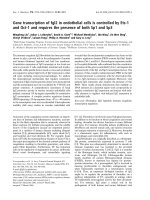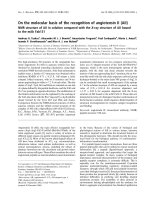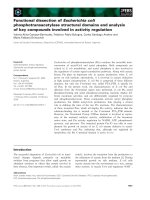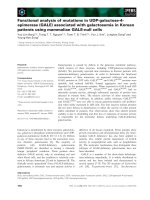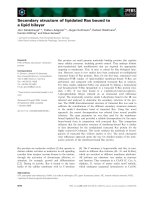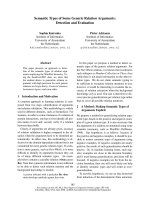Báo cáo khoa học: "The behavior of oaks in response to natural and induced exposure to the surfactant ABS" potx
Bạn đang xem bản rút gọn của tài liệu. Xem và tải ngay bản đầy đủ của tài liệu tại đây (364.49 KB, 5 trang )
Original
article
The
behavior
of
oaks
in
response
to
natural
and
induced
exposure
to
the
surfactant
ABS
S
Moricca
E
Paoletti
C
Comparini
2
1
Istituto
di
Patologia
e
Zoologia
Forestale
e
Agraria,
Piazzale
delle
Cascine,
28,
50144
Florence;
2
Centre
di
Studio
per
la
Patologia
delle
Specie
Legnose
Montane,
CNR,
Piazzale
delle
Cascine 28, 50144
Florence,
Italy
Summary —
Quercus
pubescens,
Q
frainetto,
Q
ilex
and
Q
robur
were
sprayed
with
ABS
(sodium
dodecyl
benzenesulfonate,
a
surfactant
often
found
in
marine
aerosols)
over
2
growing
seasons
to
test
the
effect
of
the
surfactant
on
the
leaf
wax
structure.
Though
all
species
were
affected,
they
dif-
fered
in
their
tolerance
to
ABS.
The
effect
of
ABS
was
also
tested
on
the
pollen
quality
of
Q
ilex.
Pol-
len
from
declining
and
apparently
healthy
individuals
was
germinated
in
cultures
with
different
con-
centrations
of
ABS.
A
negative
effect
on
pollen
germination
and
pollen
tube
length
was
noted.
The
reduction
in
pollen
viability
could
affect
the
genetic
resources
of
holm
oak
populations
in
the
future.
ABS
/
oak
spp
/
pollen
/
wax
structure
Résumé —
Réaction
des
chênes
à
l’exposition
naturelle
et
simulée
à
l’ABS.
Des
arbres
appar-
tenant
à
Quercus
pubescens,
Q
frainetto,
Q
ilex
et
Q
robur
ont
été
aspergés
d’ABS
(dodecylbenzè-
nesulfonate
de
sodium,
détergent
souvent
trouvé
dans
les
aérosols
marins)
pendant
2
saisons
de
végétation,
afin
de
tester
l’effet
du
détergent
sur
les
structures
des
cires
foliaires.
Alors
que
toutes
les
espèces
étaient
atteintes,
des
différences
spécifiques
ont
été
observées.
L’effet
de
l’ABS
sur
la
qualité
du
pollen
de
Q
ilex
a
également
été
étudié.
Le
pollen
issu
d’arbres
dépérissants
et
apparem-
ment
sains
a
été
germé
dans
des
cultures
ayant
des
concentrations
variables
d’ABS.
L’ABS
exerce
un
effet
négatif
sur
la
germination
du
grain
de
pollen
et
le
développement
du
tube
pollinique.
La
ré-
duction
de
la
viabilité
pollinique
peut
affecter
les
ressources
génétiques
du
chêne
vert
dans
le
futur.
ABS
/
chêne
/
pollen
/
cires
foliaires
INTRODUCTION
That
the
effect
of
air
pollution
on
forest
trees
varies
both
among
and
within
spe-
cies
has
been
well
established
(Karnosky
et
al,
1989),
but
there
are
still
gaps
in
our
knowledge
about
specific
pollution
effects
on
the
genetic
resources
of
forest
trees.
The
oak
forest
ecosystem
in
Europe
has
recently
begun
to
show
signs
of
’oak
de-
cline’
(Donaubauer,
1987),
the
most
nota-
ble
symptoms
of
which
are
leaf
yellowing
and
curling,
leaf
stunting,
precocious
leaf
and
twig
shedding,
failure
of
the
buds
to
break,
changes
in
the
branching
habit
and
abnormally
intense
flowering
(Gellini,
1989).
Along
the
Tuscan
coast
(where
a
large
part
of
the
vegetation
consists
of
oak),
several
symptoms
of
decline
have
been
attributed
to
wind-borne
surfactants
from
the
sea
(Gellini
et
al,
1983,
1985).
The
present
study
seeks
to
assess
the
ef-
fect
of
natural
and
artificial
exposure
to
ABS
on
the
leaf
waxes
of
4
oak
species
and
on
the
pollen
quality
of
Quercus
ilex.
MATERIALS
AND
METHODS
The
leaf
waxes
of
5-year-old
seedlings
of
Quer-
cus
pubescens
Willd,
Q
frainetto
Ten,
Q
ilex
L
and
Q
robur
L
were
sprayed
with
ABS
(sodium
dodecyl
benzenesulfonate)
and
examined
over
2
growing
seasons
(1990-1991).
Ten
seedlings
per
species
(5
for
the
spray
treatment
and
5
controls)
were
maintained
in
a
plastic
chamber
where,
during
each
growing
season,
they
were
treated
twice
weekly
for
10
weeks
with
50
mg/l
ABS
in
a
fog-type
spray.
This
concentration
cor-
responds
realistically
to
the
mean
found
in
rain-
fall
on
the
Tuscan
coast
(Bussotti
et
al,
1983).
Prior
to
treatment
each
year,
the
leaves
were
marked
and,
after
each
series
of
treatments,
2
leaves
per
tree
were
collected
and
air
dried,
as
described
by
Karhu
and
Huttunen
(1986).
From
the
middle
of
each
leaf,
2
disks
of
about
50
mm
2
each
were
removed,
1
for
upper
surface
and
1
for
lower
surface
examination.
Samples
were
sputtered
with
gold
palladium
film
and
examined
by
scanning
electron
microscopy
(SEM)
at
20
kV.
Q
ilex,
the
species
selected
for
pollen
analy-
sis,
is
common
along
the
Tuscan
coast
and
in
hilly
areas
further
inland
and
for
several
years
has
exhibited
abnormally
intense
flowering
(Gel-
lini
and
Paoletti,
1990).
Pollen
for
our
study
was
collected
in
the
San
Rossore
Park
from
1
healthy-looking
individual that
was
sheltered
from
the
sea
wind
by
other
vegetation
and
from
3
directly
exposed
and
declining
individuals.
On
these
latter
trees,
pollen
was
taken
both
from
the
windward
and
the
leeward
sides
for
compar-
ative
analysis.
Pollen
viability
was
determined
by
fluorescein
diacetate
(Heslop-Harrison
et
al,
1984).
Each
test
was
replicated
5
times.
To
de-
termine
germination,
pollen
grains
were
as-
sayed
in
cultures
of
modified
Brewbaker
and
Kwack
(1963)
solution
containing
200
g/l
of
su-
crose
and
0,
1,
3,
5
or
7
mg/l
of
ABS.
Each
as-
say
was
replicated
3
times.
The
percentages
of
germination
was
arcsin-transformed.
All
data
were
subjected
to
analysis
of
variance
and
to
Tukey’s
multiple
range
test
(P =
0.05).
RESULTS
ABS
damaged
the
leaf
waxes
of
all
spe-
cies,
though
to
different
degrees.
Damage
included:
disaggregation
and
fusion
of
the
epicuticular
and
epistomatic
wax,
deactiva-
tion
of
the
stomata
(through
occlusion
or
damage
to
the
stomatal
aperture
as
it
was
plugged
by
migrating
fused
wax
or
through
impaired
function
of
the
guard
cells),
le-
sions
and
cracks
in
the
cuticle,
trichome
abscission
and
destruction,
and
the
col-
lapse
of
the
secreting
heads
of
glandular
hairs
(fig
1A-D).
Damage
decreased
in
the
following
order:
Q
pubescens,
Q
frainetto,
Q
ilex
and
Q
robur.
The
same
trees
were
sprayed
again
in
1991:
initial
data
revealed
structural
degradation
of
the
leaf
waxes
similar
to
that
of
the
year
before,
but
the
relative
tolerance
among
the
species
was
unchanged.
In
the
culture
containing
no
ABS,
pollen
germination
was
lower
in
damaged
trees
than
in
the
healthy-looking
tree,
and
in
damaged
trees
it
was
lower
on
the
wind-
ward
side
than
on
the
leeward
side
(table
I).
However,
the
germinative
capacity
in
the
healthy-looking
individuals
was
less
than
that
reported
for
truly
healthy
Q
ilex
that
had
never
been
exposed
to
marine
aerosol
(54%)
(Bellani
et
al,
1988).
In
the
culture
without
ABS,
pollen
tubes
were
considerably
shorter
in
damaged
trees
than
in
the
’healthy’
individual
tested,
but
there
was
no
difference
in
tube
length
be-
tween
the
windward
and
leeward
sides
of
exposed
trees.
The
addition
of
ABS
to
the
culture
reduced
germination
in
all
trees.
extent
of
reduction
increased
with
in-
creasing
doses,
until 0%
germination
was
reached
at
7
mg/l
for
the
’healthy’
tree
and
5
mg/l
for
the
damaged
trees.
Increasing
ABS
concentrations
also
reduced
pollen
tube
length
in
the
’healthy’
tree,
but
not
significantly
in
declining
trees.
DISCUSSION
The
results
confirm
that
wet
depositions
of
a
substance
such
as
ABS
are
harmful
to
oaks.
The
morphological
and
physio-
logical
alterations
to
the
leaf
waxes
have
biological
consequences,
increasing
the
cuticular
transpiration
rate
and
leaving
the
tree
more
vulnerable
to
parasites
(Cape,
1983).
Pollen
quality
is
confirmed
as a
sensitive
indicator
of
air
pollution,
whether
natural
or
artificial.
Moreover,
in
the
ABS-
containing
cultures,
damaged
trees
exhib-
ited
a
lower
germination
capacity
than
healthy
trees.
Surfactant-induced
reduc-
tion
of
the
number
and
length
of
pollen
tubes
could
diminish
seed
production
and
quality
by
weakening
microgametophytic
competition
for
ovules,
or
it
could
increase
the
tolerance
of
succeeding
generations
of
trees
by
selecting
for
pollen
grains
that
are
surfactant-tolerant.
The
alterations
in
the
leaf
waxes
and
in
the
pollen
noted
in
this
study
suggest
that
current
surfactant
levels
in
nature
(Bussotti
et al,
1983)
give
cause
for
serious
concern.
Pollution
ex-
erts
selective
pressures
in
favor
of
more
tolerant
species,
but
thereby
reduces
ge-
netic
diversity,
which
is
crucial
if
species
are
to
adapt
to
changing
environmental
conditions.
REFERENCES
Bellani
LM,
Paoletti
E,
Cenni
E
(1988)
Air
pollu-
tion
effects
on
pollen
germination
of
forest
species.
In:
Sexual
Reproduction
in
Higher
Plants
(Cresti
M,
Gori
P,
Pacini
E,
eds),
Springer-Verlag,
Berlin,
265-270
Brewbaker
JL,
Kwack
BH
(1963)
The
essential
role
of
calcium
ion
in
pollen
germination
and
pollen
tube
growth.
Am
J
Bot 50,
859-865
Bussotti
F,
Rinallo
C,
Grossoni
P,
Gellini
R,
Pan-
tani
F,
Del
Panta
S
(1983)
Degrado
della
vegetazione
costiera
nella
tenuta
di
S
Ros-
sore.
Prov
Pisana
4,
46-50
Cape
JN
(1983)
Contact
angles
of
water
drop-
lets
on
needles
of
Scots
pine
(Pinus
sylves-
tris)
growing
in
the
polluted
atmospheres.
New
Phytol
93,
293-299
Donaubauer
E
(1987)
Auftreten
von
Krankheiten
und
Schädlingen
der
Eiche
und
ihr
Bezug
zum
Eichensterben.
Osterreichische
Forst-
zeitung
3,
46-48
Gellini
R
(1989)
Inquinamento
e
condizioni
di
ef-
ficienza
del
bosco.
Economia
Montana,
Linea
Ecologica
6, 11-22
Gellini
R,
Paoletti
E
(1990)
Deposizioni
acide
e
loro
effetti
sulla
vegetazione.
Atti
seminario
salvaguardia
e
gestione
ambientale,
Firenze
Nov-Dic
1989-Jan
1990,
CSSGNB,
63-69
Gellini
R,
Pantani
F,
Grossoni
P,
Bussotti
F,
Bar-
bolani
E,
Rinallo
C
(1983)
Survey
on
deterio-
ration
of
the
coastal
vegetation
in
the
park
of
San
Rossore
(central
Italy).
Eur
J For
Pathol
13, 296-304
Gellini
R,
Pantani
F,
Grossoni
P,
Bussotti
F,
Bar-
bolani
E,
Rinallo
C
(1985)
Further
investiga-
tions
on
the
causes
of
disorder
of
the
coastal
vegetation
in
the
park
of
San
Rossore
(cen-
tral Italy).
Eur
J
For
Pathol 15,
145-157
Heslop-Harrison
J,
Heslop-Harrison
Y,
Shivanna
KR
(1984)
The
evaluation
of
pollen
quality,
and
a
further
appraisal
of
the
fluorochromatic
(FCR)
test
procedure.
Theor
Appl
Genet
67,
367-375
Karhu
M,
Huttunen
S
(1986)
Erosion
effects
of
air
pollution
on
needle
surface.
Water Air
Soil
Pollut 31,
417-423
Karnosky
DF,
Berrang
PC,
Scholz
F,
Bennet
JP
(1989)
Variation
in
and
natural
selection
for
air
pollution
tolerances
in
trees.
In:
Genetic
Effects
of
Air
Pollutants
in
Forest
Tree
Popu-
lations
(Scholz
F,
Gregorius
HR,
Rudin
D,
eds)
Springer-Verlag,
Berlin,
29-37



